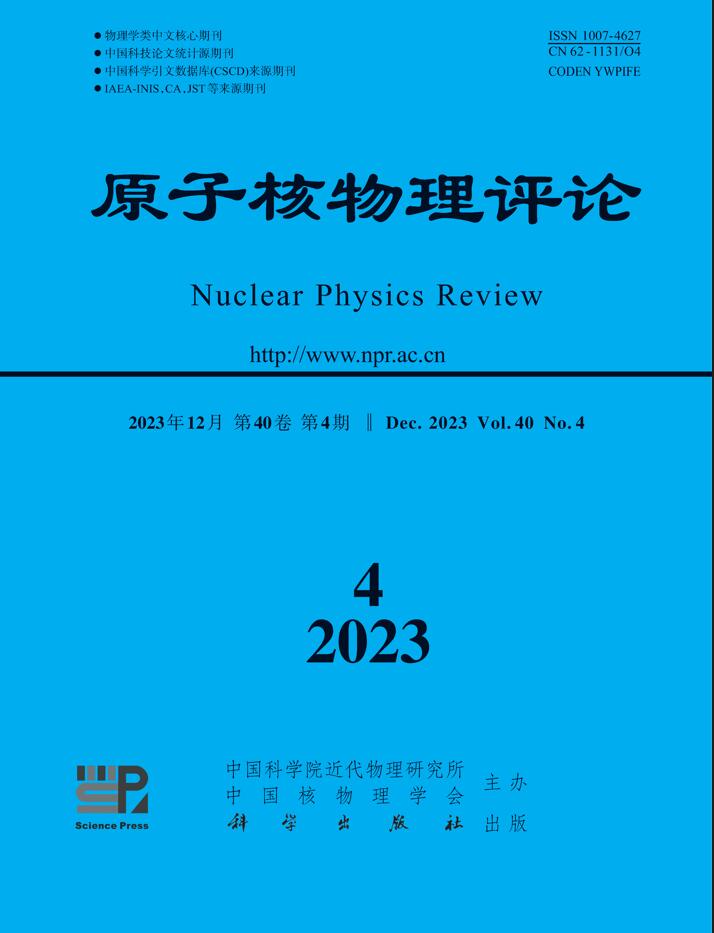1995 Vol. 12, No. 4

Display Method:
1995, 12(4): 1-5.
doi: 10.11804/NuclPhysRev.12.04.001
Abstract:
This paper briefly introduces the research and development of nuclear physics,nuclear technology and related disciplines at CAEP.It contains nine brenches: diagnostics ofpulsed nuclear reaction assembly,neutronics multi-charged atomic physics, laser fusion andplasma physics, X-ray laser,accelerator physics and technology, nuclear electronics, nuclear arms control physics and applications of nuclear technology.
This paper briefly introduces the research and development of nuclear physics,nuclear technology and related disciplines at CAEP.It contains nine brenches: diagnostics ofpulsed nuclear reaction assembly,neutronics multi-charged atomic physics, laser fusion andplasma physics, X-ray laser,accelerator physics and technology, nuclear electronics, nuclear arms control physics and applications of nuclear technology.
1995, 12(4): 6-10.
doi: 10.11804/NuclPhysRev.12.04.006
Abstract:
The uses,status and tendency of the two essential atomic models were presented emphatically.They are the average atom (AA) model and the detailed configurationaccounting (DCA)model.Concerning atomic processes in hot plasmas,the electron-ion collision and the dielectronic recombination were introduced especially.However,the experimental status were less presented. The general situation were presented in this paper.
The uses,status and tendency of the two essential atomic models were presented emphatically.They are the average atom (AA) model and the detailed configurationaccounting (DCA)model.Concerning atomic processes in hot plasmas,the electron-ion collision and the dielectronic recombination were introduced especially.However,the experimental status were less presented. The general situation were presented in this paper.
1995, 12(4): 11-15.
doi: 10.11804/NuclPhysRev.12.04.011
Abstract:
The basic principle,construction and characteristics of the LIA, together witha summary of the recent developments and achivements in the scientific field both at homeand abroad are presented in this paper.A10MeV LIA has been developed at IFP, CAEP forflash X-ray radiography application.A 2.4kA,70ns electron beam can be transportedthrough the accelerator, while 2.1kA is focused onto the target (Ta) With about 4mm spotto produce intensive pulsed X-ray.The dosage is 3×10 ̄(-2)C/kg at 1 meter from...
The basic principle,construction and characteristics of the LIA, together witha summary of the recent developments and achivements in the scientific field both at homeand abroad are presented in this paper.A10MeV LIA has been developed at IFP, CAEP forflash X-ray radiography application.A 2.4kA,70ns electron beam can be transportedthrough the accelerator, while 2.1kA is focused onto the target (Ta) With about 4mm spotto produce intensive pulsed X-ray.The dosage is 3×10 ̄(-2)C/kg at 1 meter from...
1995, 12(4): 16-18.
doi: 10.11804/NuclPhysRev.12.04.016
Abstract:
In this paper the research progress of high pulsed power technology and its applications in the. past 30 years in CAEP have been briefly introduced. Meanwhile, related important topics of future development are also given. High pulsed power is a more dynamicscience and technology at the front position in the world. It has a wide great future.
In this paper the research progress of high pulsed power technology and its applications in the. past 30 years in CAEP have been briefly introduced. Meanwhile, related important topics of future development are also given. High pulsed power is a more dynamicscience and technology at the front position in the world. It has a wide great future.
1995, 12(4): 19-20.
doi: 10.11804/NuclPhysRev.12.04.019
Abstract:
The current status and progress are outlined in few-body nuclear physics research. Latest trends in this field are reviewed as well.
The current status and progress are outlined in few-body nuclear physics research. Latest trends in this field are reviewed as well.
1995, 12(4): 21-26.
doi: 10.11804/NuclPhysRev.12.04.021
Abstract:
The diasnostic instruments and some physical results about laser fusion experiments in our laboratory are briefly described. The achievements in direct and indirect drivenimpulsion performed in China are also given here.
The diasnostic instruments and some physical results about laser fusion experiments in our laboratory are briefly described. The achievements in direct and indirect drivenimpulsion performed in China are also given here.
1995, 12(4): 27-30.
doi: 10.11804/NuclPhysRev.12.04.027
Abstract:
This paper introduces the progress on X-ray laser investigations in CAEP,including the experiments of X-ray lasers gain of Ne-like Ge pumped by electron-collision excitation, double-pass amplification of X-ray laser, low enery double-pulse driving and X-raylasers pumped by other schemes. The attentions are paid to the experimental principles, designs and results. Some suggestions of future investigations are also discussed.
This paper introduces the progress on X-ray laser investigations in CAEP,including the experiments of X-ray lasers gain of Ne-like Ge pumped by electron-collision excitation, double-pass amplification of X-ray laser, low enery double-pulse driving and X-raylasers pumped by other schemes. The attentions are paid to the experimental principles, designs and results. Some suggestions of future investigations are also discussed.
1995, 12(4): 31-32.
doi: 10.11804/NuclPhysRev.12.04.031
Abstract:
The fundamental results on nuclear fusion research at normal temperature inCAEP Institute of Nuclear Physics and Chemistry are briefly described in this paper.Anomalous phenomenon in metal loaded with deuterium has been studied by using gas-discharge, electrolysis and the cycle method of temperature and pressure. About 10 ̄4n/s and X-ray for single energy 27keV were found. The production of neutron and X-ray is the repeatability of one hundred percent.
The fundamental results on nuclear fusion research at normal temperature inCAEP Institute of Nuclear Physics and Chemistry are briefly described in this paper.Anomalous phenomenon in metal loaded with deuterium has been studied by using gas-discharge, electrolysis and the cycle method of temperature and pressure. About 10 ̄4n/s and X-ray for single energy 27keV were found. The production of neutron and X-ray is the repeatability of one hundred percent.
1995, 12(4): 33-36.
doi: 10.11804/NuclPhysRev.12.04.033
Abstract:
In this paper the recent status and unsolved problems on tritium technologyand tritium breeding material study for fusion-fission hybrid reactor (FFHR) are described.The achievements in the research area in our institute are briefly introduced.Some suggestions on further tritium research are given.
In this paper the recent status and unsolved problems on tritium technologyand tritium breeding material study for fusion-fission hybrid reactor (FFHR) are described.The achievements in the research area in our institute are briefly introduced.Some suggestions on further tritium research are given.
1995, 12(4): 37-40.
doi: 10.11804/NuclPhysRev.12.04.037
Abstract:
This paper briefly describes high power laser technology for ICF drivers andestimates its present status, key technology and.developing trend. In particular, a description of the laser driver key technical progress and near future program in CAEP are also presented herewith.
This paper briefly describes high power laser technology for ICF drivers andestimates its present status, key technology and.developing trend. In particular, a description of the laser driver key technical progress and near future program in CAEP are also presented herewith.
1995, 12(4): 41-43.
doi: 10.11804/NuclPhysRev.12.04.041
Abstract:
For more than 30 years physical diagnostic techniques of transient pulse nuclear radiations have been made in CAEP. In this paper the physical diagnostic techniques andtheir progress in characteristics of time, energy spectrum and time-energy spectrum of transient pulse neutrons, γand X-rays are summarized.
For more than 30 years physical diagnostic techniques of transient pulse nuclear radiations have been made in CAEP. In this paper the physical diagnostic techniques andtheir progress in characteristics of time, energy spectrum and time-energy spectrum of transient pulse neutrons, γand X-rays are summarized.
1995, 12(4): 44-45.
doi: 10.11804/NuclPhysRev.12.04.044
Abstract:
The results of nuclear pumping Ne, He, Ar, Xe are introduced in this paper. ̄(238)Pu was used to exite Ne, Ne-Ar, Ne-He, Ne-H_2 systems. The elimination rate constantsof Ne (2p_1 ) by Ne,He,H_2,Ar were measured. 300 ̄# stable reactor was used to encourage HeNe system, the gain measured was 2 ×10 ̄(-2)/cm. Lasing experiment of He-Ar-Xe system wasdone on CFBR-Ⅱ pulse reactor, lasing sign was measured, λ=1.73μp, lasing power wasabout 10 mW.
The results of nuclear pumping Ne, He, Ar, Xe are introduced in this paper. ̄(238)Pu was used to exite Ne, Ne-Ar, Ne-He, Ne-H_2 systems. The elimination rate constantsof Ne (2p_1 ) by Ne,He,H_2,Ar were measured. 300 ̄# stable reactor was used to encourage HeNe system, the gain measured was 2 ×10 ̄(-2)/cm. Lasing experiment of He-Ar-Xe system wasdone on CFBR-Ⅱ pulse reactor, lasing sign was measured, λ=1.73μp, lasing power wasabout 10 mW.
1995, 12(4): 46-49.
doi: 10.11804/NuclPhysRev.12.04.046
Abstract:
The soft X-ray emission spectra from very highly stripped ions of the medium Z elements of_(22)T,_(26)Fe,_(28)Ni,_(29)Cu,_(30)Zn and_(32)Ge, and the high-Z elements of_(72)Hf,_(73)Ta,_(74)Wand_(75)Re have been observed in laser-produced plasmas generated by focusing a Nd-glasslaser beam onto the surface of the plane solid targets at the "Xing Guang" laser facility. Thespectra in the range of 3. 6-300A were recorded by using four flat crystal spectrographyswith different 2d spacting...
The soft X-ray emission spectra from very highly stripped ions of the medium Z elements of_(22)T,_(26)Fe,_(28)Ni,_(29)Cu,_(30)Zn and_(32)Ge, and the high-Z elements of_(72)Hf,_(73)Ta,_(74)Wand_(75)Re have been observed in laser-produced plasmas generated by focusing a Nd-glasslaser beam onto the surface of the plane solid targets at the "Xing Guang" laser facility. Thespectra in the range of 3. 6-300A were recorded by using four flat crystal spectrographyswith different 2d spacting...
1995, 12(4): 50-53.
doi: 10.11804/NuclPhysRev.12.04.050
Abstract:
The recent developmet of ICF target in our institute is presented in this paper.With regard to the fabrication of thermal nuclear fusion target, the paper reveals the resultsof the fabrication of hollow glass microsphere (HGM), hollow plastic microsphere and deuterium-tritium gas-filling technique. The results of characterization and fluorencence analysisof fuel gas are also given out. In addition, due to its importance, the paper describes brieflythe internal and external developments of cryogenis target.
The recent developmet of ICF target in our institute is presented in this paper.With regard to the fabrication of thermal nuclear fusion target, the paper reveals the resultsof the fabrication of hollow glass microsphere (HGM), hollow plastic microsphere and deuterium-tritium gas-filling technique. The results of characterization and fluorencence analysisof fuel gas are also given out. In addition, due to its importance, the paper describes brieflythe internal and external developments of cryogenis target.
1995, 12(4): 54-57.
doi: 10.11804/NuclPhysRev.12.04.054
Abstract:
Since 1960s, the fusion neutronics integral experiments have been carried outin our institute. Several research subjects, including the measurements of the tritium production rate,the fission rate,the leakage rate and the neutron energy spectra, have been finished. Since 1987,neutronics integral experiments of the blanket in the fusion-fission hybridreactor in the "863" project have been taken on. The experiments of 14MeV neutron multiplication in Be and Pb have been performed and the experimental error is ...
Since 1960s, the fusion neutronics integral experiments have been carried outin our institute. Several research subjects, including the measurements of the tritium production rate,the fission rate,the leakage rate and the neutron energy spectra, have been finished. Since 1987,neutronics integral experiments of the blanket in the fusion-fission hybridreactor in the "863" project have been taken on. The experiments of 14MeV neutron multiplication in Be and Pb have been performed and the experimental error is ...
1995, 12(4): 58-60.
doi: 10.11804/NuclPhysRev.12.04.058
Abstract:
The main specifications, structure and applications of CFBR-Ⅱ are simply introduced in this paper. The reactor s installations and fscilities are also mentioned.
The main specifications, structure and applications of CFBR-Ⅱ are simply introduced in this paper. The reactor s installations and fscilities are also mentioned.
1995, 12(4): 61-63.
doi: 10.11804/NuclPhysRev.12.04.061
Abstract:
In this paper, the coupled neutron and γ-ray transport equations and nuclearnumber density equations, and its computer program systems concerned in fusion-fission hybrid reactor design are briefly described. The current status and focal point for coming workof nuclear data used in fusion reactor design are explained.
In this paper, the coupled neutron and γ-ray transport equations and nuclearnumber density equations, and its computer program systems concerned in fusion-fission hybrid reactor design are briefly described. The current status and focal point for coming workof nuclear data used in fusion reactor design are explained.
1995, 12(4): 64-69.
doi: 10.11804/NuclPhysRev.12.04.064
Abstract:
The status of theoretical study on detection of hidden explosives in IAPCM ispresented. The analysis of the working principles of the instrumentations and the relatedcomputational codes and nuclear. data needed are discussed.
The status of theoretical study on detection of hidden explosives in IAPCM ispresented. The analysis of the working principles of the instrumentations and the relatedcomputational codes and nuclear. data needed are discussed.
1995, 12(4): 70-73.
doi: 10.11804/NuclPhysRev.12.04.070
Abstract:
The study on 1032-A type controllable neutron source is described in this paper. The source can meet with inelastic scattering of fast neutron and material, generate inelastic γ-ray and measured its characteristic energy, and examined explosive material andother substance component.
The study on 1032-A type controllable neutron source is described in this paper. The source can meet with inelastic scattering of fast neutron and material, generate inelastic γ-ray and measured its characteristic energy, and examined explosive material andother substance component.
1995, 12(4): 74-76.
doi: 10.11804/NuclPhysRev.12.04.074
Abstract:
The main recent progress of study on hidden explosive detection means ofpulse fast neutrons in the institute of Applied Electronics, CAEP, is introduced.
The main recent progress of study on hidden explosive detection means ofpulse fast neutrons in the institute of Applied Electronics, CAEP, is introduced.
1995, 12(4): 77-79.
doi: 10.11804/NuclPhysRev.12.04.077
Abstract:
Some main issues and problems involved in nuclear arms control study, suchas nuclear policy, NPT regime, verification technologies for a CTBT and disposal of drilitarynuclear materials are introduced, in which both the existing state and prospects of these issues are analyzed.
Some main issues and problems involved in nuclear arms control study, suchas nuclear policy, NPT regime, verification technologies for a CTBT and disposal of drilitarynuclear materials are introduced, in which both the existing state and prospects of these issues are analyzed.
1995, 12(4): 80-82.
doi: 10.11804/NuclPhysRev.12.04.080
Abstract:
The studies on radiation environmental protection in recent 20 years in INPC are briefly introduced, which include the monitoring and treatment of radioactive effluents, environmental monitoring and dose assesment.
The studies on radiation environmental protection in recent 20 years in INPC are briefly introduced, which include the monitoring and treatment of radioactive effluents, environmental monitoring and dose assesment.
1995, 12(4): 83-84.
doi: 10.11804/NuclPhysRev.12.04.083
Abstract:
In this paper the activities of radiation safety and environmental protectionwork in CAEP are briefly reviewed.
In this paper the activities of radiation safety and environmental protectionwork in CAEP are briefly reviewed.
1995, 12(4): 85-86.
doi: 10.11804/NuclPhysRev.12.04.085
Abstract:
We have made wide researches on the safety protection on tritium in order toprevent the tritium radioactive toxicity. Systematic and comprehensive understanding isachieved in many aspects like the protection emphasis on tritium gas contactors, the mostpreferable measurement for the protection of tritium gas internal irradistion toxicity, the particular law of tritium gas internal irradiation dosage monitoring, and the principal involvedorgans of tritium-induced non-random radiative effects...
We have made wide researches on the safety protection on tritium in order toprevent the tritium radioactive toxicity. Systematic and comprehensive understanding isachieved in many aspects like the protection emphasis on tritium gas contactors, the mostpreferable measurement for the protection of tritium gas internal irradistion toxicity, the particular law of tritium gas internal irradiation dosage monitoring, and the principal involvedorgans of tritium-induced non-random radiative effects...
1995, 12(4): 87-89.
doi: 10.11804/NuclPhysRev.12.04.087
Abstract:
reactor is a pool type of research reactor. In this paper the basic featureof the reactor, and several experimental devices and their properties are introduced. It wassummarized that the experiment and study work is developed on the reactor, such as neutronand nuclear physics, nuclear chemistry, material science, and a few irradiated products byneutron and their applications and so on.
reactor is a pool type of research reactor. In this paper the basic featureof the reactor, and several experimental devices and their properties are introduced. It wassummarized that the experiment and study work is developed on the reactor, such as neutronand nuclear physics, nuclear chemistry, material science, and a few irradiated products byneutron and their applications and so on.
1995, 12(4): 90-92.
doi: 10.11804/NuclPhysRev.12.04.090
Abstract:
An in-pile tritium production apparatus in SPRR-300 and its main charactersare introduced. The operation of the apparatus and the tritium release experiments arebriefly described. The utilization of the apparatus in tritium production study of fusionfission hybrid reactor blanket and its future are reviewed.
An in-pile tritium production apparatus in SPRR-300 and its main charactersare introduced. The operation of the apparatus and the tritium release experiments arebriefly described. The utilization of the apparatus in tritium production study of fusionfission hybrid reactor blanket and its future are reviewed.
1995, 12(4): 93-95.
doi: 10.11804/NuclPhysRev.12.04.093
Abstract:
The types and quantities of radioisotopes used in medicine have been developedgreatly in these years. The new labeling compounds supplied a safe, fast and accuratemethod for human tissue diagnostic and function dynamic studies. The tumor therapeutic radiopharmaceutical can concentrate its ray to irradiate the diseased tissue, and the probabilityof leukema and else disease caused by irradiating is much lower. This method is nontraumatic so that the tumor therapy by radiopharmaceutical is ....
The types and quantities of radioisotopes used in medicine have been developedgreatly in these years. The new labeling compounds supplied a safe, fast and accuratemethod for human tissue diagnostic and function dynamic studies. The tumor therapeutic radiopharmaceutical can concentrate its ray to irradiate the diseased tissue, and the probabilityof leukema and else disease caused by irradiating is much lower. This method is nontraumatic so that the tumor therapy by radiopharmaceutical is ....
1995, 12(4): 96-99.
doi: 10.11804/NuclPhysRev.12.04.096
Abstract:
On the basis of introducing into principal concept for nuclear installation decommissioning,form policy, sciences point of view, we analyse present problems in the policy, the administrative and programme for decommissioning work in our country. Accordingto the physical process of decommissioning, we studied engineering economics, derivedmethod and formulas to estimete decommissioning cost. We point out that basing on optimization principle for radiation protection and analysing cost-benefit for...
On the basis of introducing into principal concept for nuclear installation decommissioning,form policy, sciences point of view, we analyse present problems in the policy, the administrative and programme for decommissioning work in our country. Accordingto the physical process of decommissioning, we studied engineering economics, derivedmethod and formulas to estimete decommissioning cost. We point out that basing on optimization principle for radiation protection and analysing cost-benefit for...







 甘公网安备 62010202000723号
甘公网安备 62010202000723号